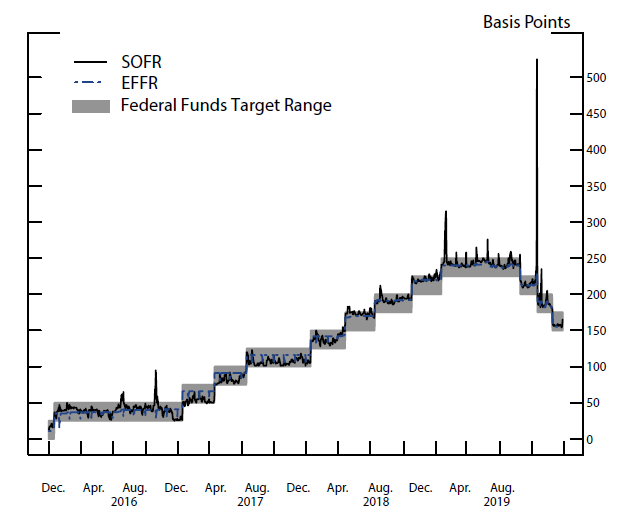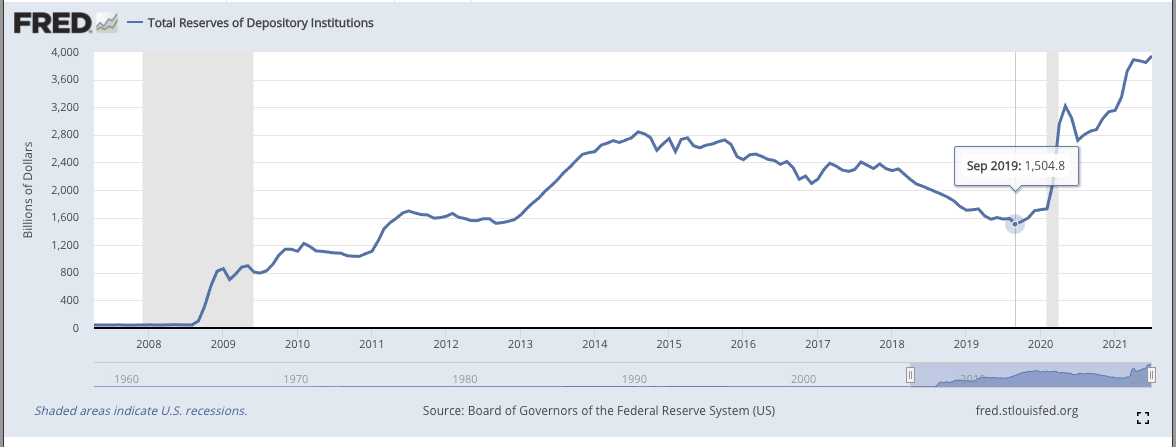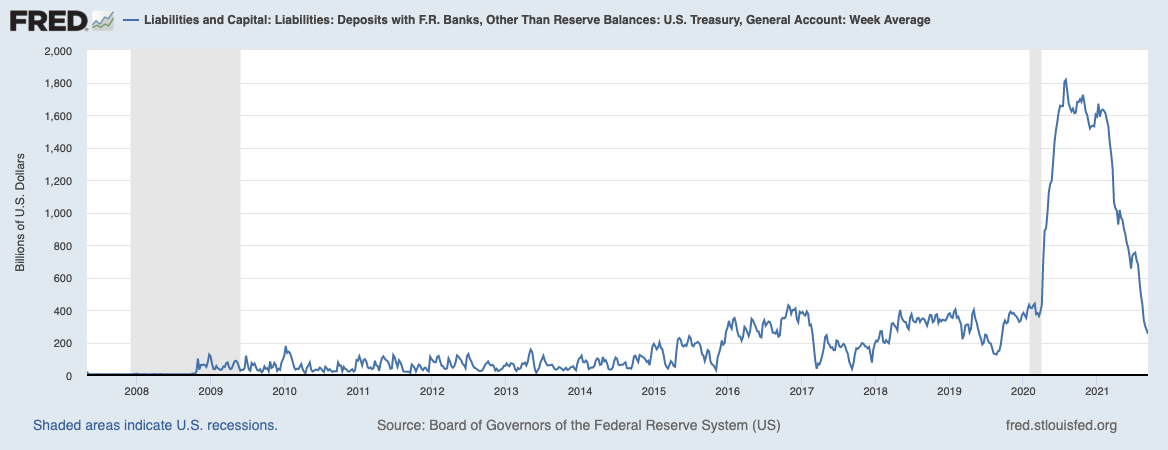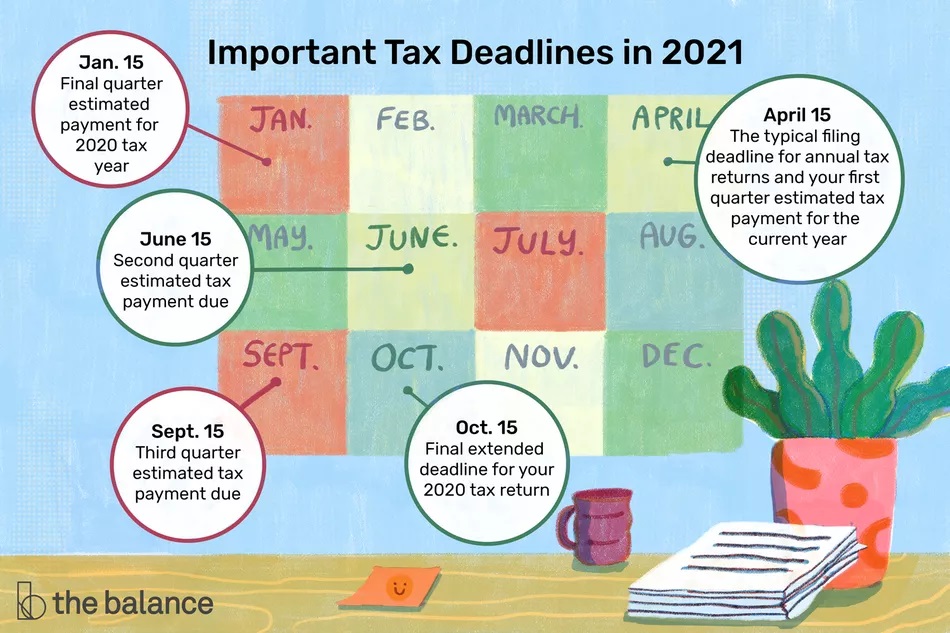Nasdaq Index Analysis
Each year something happens in September just as the US fiscal year is coming to an end. Last year was slightly different because the emergency responses to COVID-19 distorted policy, but this year, most if not all emergency policy measures have been removed, so it’s more like 2019, and in that year, September was a crazy time in the markets.


In mid-September 2019, the overnight money market rates spiked amid a large drop in reserves due to the corporate tax date and increases in net Treasury issuance. The internal plumbing of the financial system was called into question and interest rates were out of control, though only briefly. Quarterly corporate tax payments that were due on September 16 were withdrawn from bank and money market mutual fund (MMF) accounts and went to the Treasury’s account at the Federal Reserve. Concurrent with the Corporate taxes received by the Fed, $54 billion of long-term Treasury debt was settled on September 16, which increased the Treasury holdings of primary dealers that purchase these securities at auctions and finance them through the repo market. One thing I would like to point out is that the sale of US Treasuries is a reserve drain, it’s not borrowing money. The US dollars are in the system, the sale of Treasuries is just a re-composition of assets. As tax payments and the settlement of Treasury auctions drained a large amount of cash, reserves in the banking system declined by about $120 billion over two business days.


After 2007 and the Global Financial Crisis the level of reserves ballooned from $10billion to $2.8trillion, and by August 2019 it had been reduced to the point where the ratio of reserves on the account didn’t meet the requirements of the money markets. The Fed had fallen asleep at the wheel and tapered too far. Looking at the level of reserves now, it is almost unbelievable how large this account has got.


Roll on 2 years and the world has gone through a global pandemic, where a key response was to flood the TGA with trillions of dollars to pay for emergency programmes. Treasury Secretary Yellen has had to reduce this account down to more normal levels which in turn had made the reserves continue to grow higher, as the cash from the TGA landed on the commercial banks’ balance sheets. There has been lots of talk of how the fed will have to taper these reserves due to the rising inflation, but so far nothing has been reduced and maybe it won’t be. We’ll find out probably in November 2021.


Today is a key date for paying corporate tax, there is a deadline for third quarter estimated tax payments for the 2021 tax year. Plus, a final deadline to file partnership and S corporation tax returns for the tax year 2020, if an extension was requested (Forms 1065 and 1120-S), which means once again there will be a flood of money heading out of the banks and MMF and into the Treasury account held at the Fed.
If we assume that the people in control like Yellen and Powell have learned their lessons from 2019, we can dismiss the markets being at breaking point and can expect the commercial banks to have some room on their balance sheets to purchase some trading assets, like equities.
There is a ratio that banks must keep too called the Supplementary Leverage Ratio, where the SLR = Tier 1 capital / consolidated assets. This ratio must be 3% or greater. Reserves are part of consolidated assets and reserves are created when banks receive deposits. Add reserves to the balance sheet of a bank and the denominator goes up, making the ratio come down. A small ratio leaves less room for new assets, like loans. Shift a load of cash off the books as people pay their taxes and that is a way of draining reserve assets which means the SLR ratio goes up and the banks suddenly have room to add things like derivatives, stocks etc.
See real-time quotes provided by our partner.
Since the coronavirus pandemic lows in the equities markets, the trend has been higher. With several opportunities to buy the daily 50 ema on the S&P500 and rise it for 100% gains.
Over the last few weeks talk around Fed taper, raising rates, inflation, and political impasse blocking new fiscal stimulus and the debt ceiling, have all turned sentiment neutral to bearish. Today the S&P500 hasn’t yet visited the daily 50 ema but if, or should I say when, it does, it will be interesting to see who buys the dip. The alternative being, those assuming it will eventually get to the 50 ema miss out as banks front-run their levels.
See real-time quotes provided by our partner.
The Nasdaq daily chart also shows that the trend in the moving averages for over a year now is to the upside, but recent price action has been lower daily highs and lower daily lows, which is technically a short-term downtrend. With price arriving in an old balance area this week, there may be an opportunity to get back in line with long term momentum.
The bond market has risen over the last few days and today’s actions don’t seem to be going crazy in the short end of the curve, so I am assuming all is well with the financial system’s plumbing, after all, there are a lot of reserves in the Fed account. Looking for reasons to buy the dip in the Nasdaq is hard when I know that there is a high probability the banks will be buying, but never really knowing exactly where.
See real-time quotes provided by our partner.
Over the last 11 trading sessions, 7 of them have started with the US session high printing within the first hour from the US Open. So, seeing price run-up into a supply level in the first 60 mins has been a great shorting opportunity. This basically happened today. Making it 8/11.
See real-time quotes provided by our partner.
If you look left along the lows in the above chart for the last few sessions, there is clearly a double bottom, and the green box is the daily balance area price zone that formed back in August 2021. I am going to assume that any institution that would like to buy the Nasdaq would have been willing to do so as speculators got short or anyone long with a stop below the doble bottom puked their position as price ran through them.
Buying that low print today would have been a great speculative trade, backed up with the idea that commercial banks could be buying alongside you. However, for those reading this it is obviously too late, Sorry. What I would hope is that going forward, recognising how a higher time frame trend is valid for trade direction. And that a trading edge can be finding areas on the chart where you can trade in line with that higher time frame giving you a good risk to reward ratio, even against recent price action. There is a chance that this, buy the dip entry once again gets run over, in which case a more conservative long entry would be to wait for a break above the high of the US open today. As this is becoming a rare occurrence it would be a possible signal of a change in the way the market participants are acting and maybe a signal that they had stopped selling. In which case a retest of that old resistance to act as support with a continuation trade higher would be valid.
© 2020 YouTrading UK - Leaders in Trader Training.
| Cookie | Duration | Description |
|---|---|---|
| __cfduid | 1 month | The cookie is used by cdn services like CloudFare to identify individual clients behind a shared IP address and apply security settings on a per-client basis. It does not correspond to any user ID in the web application and does not store any personally identifiable information. |
| _wpfuuid | 11 years | This cookie is used by the WPForms WordPress plugin. The cookie is used to allows the paid version of the plugin to connect entries by the same user and is used for some additional features like the Form Abandonment addon. |
| cf_use_ob | This cookie is set by the provider Cloudflare content delivery network. This cookie is used for determining whether it should continue serving "Always Online" until the cookie expires. | |
| cookielawinfo-checbox-analytics | 11 months | This cookie is set by GDPR Cookie Consent plugin. The cookie is used to store the user consent for the cookies in the category "Analytics". |
| cookielawinfo-checbox-functional | 11 months | The cookie is set by GDPR cookie consent to record the user consent for the cookies in the category "Functional". |
| cookielawinfo-checbox-others | 11 months | This cookie is set by GDPR Cookie Consent plugin. The cookie is used to store the user consent for the cookies in the category "Other. |
| cookielawinfo-checkbox-advertisement | 1 year | The cookie is set by GDPR cookie consent to record the user consent for the cookies in the category "Advertisement". |
| cookielawinfo-checkbox-necessary | 11 months | This cookie is set by GDPR Cookie Consent plugin. The cookies is used to store the user consent for the cookies in the category "Necessary". |
| cookielawinfo-checkbox-performance | 11 months | This cookie is set by GDPR Cookie Consent plugin. The cookie is used to store the user consent for the cookies in the category "Performance". |
| viewed_cookie_policy | 11 months | The cookie is set by the GDPR Cookie Consent plugin and is used to store whether or not user has consented to the use of cookies. It does not store any personal data. |
| Cookie | Duration | Description |
|---|---|---|
| YSC | session | This cookies is set by Youtube and is used to track the views of embedded videos. |
| Cookie | Duration | Description |
|---|---|---|
| _ga | 2 years | This cookie is installed by Google Analytics. The cookie is used to calculate visitor, session, campaign data and keep track of site usage for the site's analytics report. The cookies store information anonymously and assign a randomly generated number to identify unique visitors. |
| _gid | 1 day | This cookie is installed by Google Analytics. The cookie is used to store information of how visitors use a website and helps in creating an analytics report of how the website is doing. The data collected including the number visitors, the source where they have come from, and the pages visted in an anonymous form. |
| Cookie | Duration | Description |
|---|---|---|
| _fbp | 3 months | This cookie is set by Facebook to deliver advertisement when they are on Facebook or a digital platform powered by Facebook advertising after visiting this website. |
| fr | 3 months | The cookie is set by Facebook to show relevant advertisments to the users and measure and improve the advertisements. The cookie also tracks the behavior of the user across the web on sites that have Facebook pixel or Facebook social plugin. |
| IDE | 1 year 24 days | Used by Google DoubleClick and stores information about how the user uses the website and any other advertisement before visiting the website. This is used to present users with ads that are relevant to them according to the user profile. |
| test_cookie | 15 minutes | This cookie is set by doubleclick.net. The purpose of the cookie is to determine if the user's browser supports cookies. |
| VISITOR_INFO1_LIVE | 5 months 27 days | This cookie is set by Youtube. Used to track the information of the embedded YouTube videos on a website. |
| Cookie | Duration | Description |
|---|---|---|
| _gat_UA-42160853-2 | 1 minute | No description |
| cf_ob_info | No description | |
| CONSENT | 16 years 8 months 3 days 6 hours 2 minutes | No description |